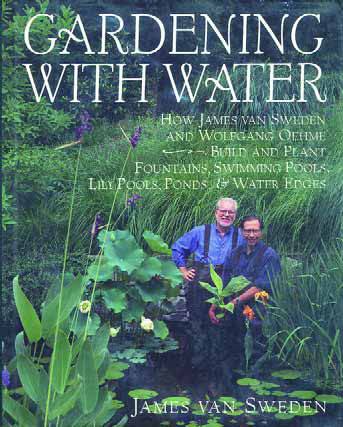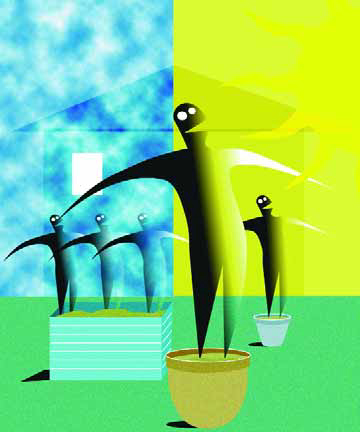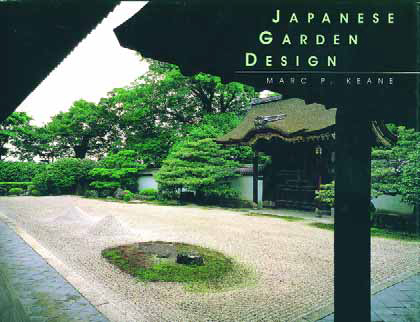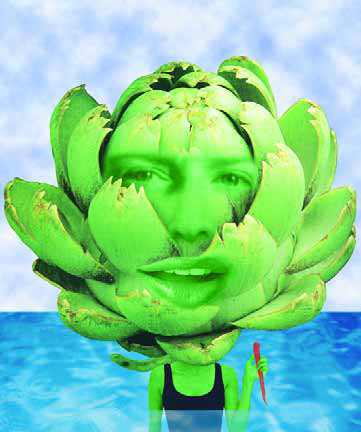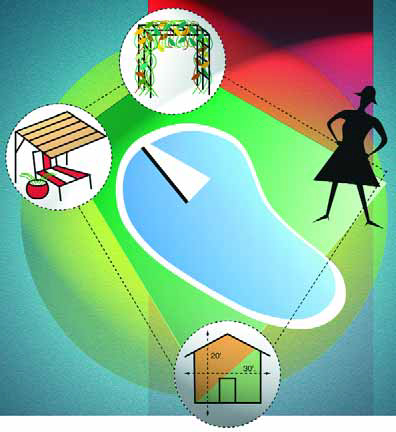plants
Home to some of the world's greatest outdoor spaces, Kyoto, Japan, is a garden lover's heaven. If you make the trip, however, there is one garden that stands above all others - an aesthetic treasure, a nature-inspired garden masterpiece that is quite possibly the most beautiful place I've ever been. Owned by the Japanese imperial family, Katsura Rikyu (pronounced kah-tsu-rah ree-kyu) is an estate in Western Kyoto near the Katsura River. Rikyu means "detached palace," but that translation is a little misleading to English speakers, because the estate does not
Without any hesitation at all, I can say that Gardening with Water by James Van Sweden (Random House, 1995) is one of the most influential books on design that I've ever read. It's currently out of print, but it's certainly worth a hunt and can still be found on the Internet and in many technical bookstores. All through its 206 beautifully illustrated pages, Van Sweden carefully details his approach to designing with water - an element he says should be used in some form in every garden design. Along the way, he covers his firm's use of swimming pools (natural and architectural) as well as birdbaths, fountains, small watergardens and large ponds. It's an important book from a tremendously influential designer. In fact,
We've spent a lot of time in these columns talking about ways of adding dimension and interest to gardens by using different planting styles and arrangements and by varying color, texture, size, quantity and other planted features of the design. As yet, however, we haven't spent any time at all on one of the easiest and potentially most interesting ways of giving a design a unique character - one that virtually forces visitors to remember your garden. It's all about containers and accessories. As simple as it seems, adding containers and other accessories - anything from simple terra cotta pots or stone benches to elaborately custom-built planter boxes or beautifully detailed garden statuary - can add marks of
It all begins with the water. The first thing anyone approaching the world of ponds needs to understand is that life-supporting water is quite unlike the sterile water found in swimming pools or spas or many other watershapes. A second and related point is that clear water is not necessarily healthy water when it comes to the needs of the inhabitants of the pond. For a pond to be healthy, its water must meet the chemical requirements of plants and fish by having an abundance of some things (such as nutrients) and a near-total lack of other things (such as pollutants). Sanitized water may be beautifully clear, but the fact that sterile systems are designed to knock out nutrients and work chemically because they are "polluted" with chlorine and algaecides makes them completely unsuitable as life-supporting ecosystems. The goal with ponds is to work with nature in balancing the life-sustaining features of the water - and to set things up in such a way that maintaining that balance will be something your clients can do long after you've moved along to another project. To do so, you need to embrace the water-quality basics outlined in the last issue of
If you've been looking for a well-written, beautifully illustrated book that cracks the code when it comes to the design principles of Japanese gardening and introduces the full range of styles found in this ancient art form, you can't go wrong with Japanese Garden Design. Written by designer Marc P. Keane (and published by Charles E. Tuttle in 1996 but still in print), the book offers a detailed examination of this most influential of styles. For watershapers, landscape designers and
Imagine your clients in this scene: It's a warm, summer evening, dinner for two on the patio is almost ready, the waterfall is on, and candlelight is reflecting on the surface of the pond. But the salad isn't quite complete, so this evening's chef steps into the yard, clips some chives from a clump near the water's edge and adds a finishing touch to the composition. Later, they pick a few plums and apricots for dessert, relaxed and about as happy as they could be in their backyard. Though the setting is delightful, it's the edible plants that complete the experience. And as was mentioned last time, with more and more people wanting
It's a tale of two professions: Pool and spa people are taught to keep things dead; pond people are taught to keep things alive. Pool people sell chlorine; pond people sell de-chlorinator. Pool people sterilize; pond people fertilize. This contrast in approaches to basic water maintenance is perhaps the most significant difference between two trades that are coming into closer and closer contact with one another every day. At issue between the two groups is whether to work against nature in a sterile system, or work with it to create an ecosystem. Each discipline has a foundation in the science of water chemistry and both have a place in the world - but beyond that (and as the table below demonstrates), things really couldn't be much different. As more and more pool/spa professionals move into water gardening and more and more landscape designers and architects get into pools and spas, there's an increasing need for all of us to understand these water-treatment distinctions and the basics of each approach. I come from the pond side, so I'll cover things from that perspective in a pair of articles - a science-oriented overview this time before we
The ancient Celts transported huge slabs of stone over long distances to create religious circles at Stonehenge and Avebury. The Romans used stone to build their aqueducts. From the pyramids of Egypt to the Acropolis in Athens, from the Great Wall of China to the great castles of Europe, stone has been the raw material of choice for our greatest and most enduring structures. Through the ages, stone has been a well-used material because it is both durable and readily available. It's hard to find a town in Europe without walls constructed of local stone, and all you need do is drive through
Looking for inspiration in an urban environment can leave a designer with precious few useful references. Take downtown Chicago, for example, where our indigenous waterfeature is Lake Michigan and our public art is too often plopped in the middle of concrete plazas. Be that as it may, I do my part by trying to introduce both water and art into my projects. So I was thrilled to be retained by Mary O'Shaughnessy, owner of the Wood Street Gallery in Chicago, to design a sculpture garden. I knew it would give me the chance to create a balanced, beautiful space - even though I also knew the job wouldn't be easy. What she wanted was a garden environment in which she could display and sell contemporary American sculpture - a place that would help clients visualize the way the art might look in their own gardens. As we dug deeper, we uncovered additional goals: It needed to be a space that would accommodate a changing variety and number of pieces; it had to be functional for large parties; and it had to incorporate and acknowledge the garden's urban neighborhood while still providing a sense of enclosure for gallery visitors (and, of course,
Contrary to the impression that might be given by the headline, this isn't an article about building arbors that are safe. Rather, it's about how you can protect your clients and their guests from the sun by building beautiful structures in their yards. (Safety is part of the discussion, too, but not its focus.) I bring this up because many clients put piles of money into building spectacular pools but fail to give much thought to their surroundings. That's a shame, because those surroundings almost certainly will be seen much more than the pools will be used in the course of the average year. Several things need to be











